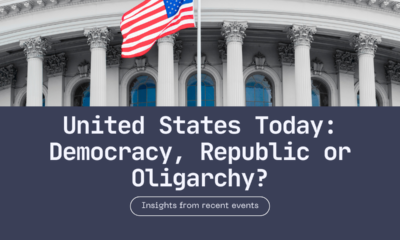Civilization
New Report Highlights Green Failure in Europe and Warns America
Net zero in Great Britain has been an abject failure, with sky-high energy costs, stunted economic growth, and an unreliable grid.

As one digests Rupert Darwall’s latest report for the RealClear Foundation, the well-known quote from Spanish philosopher George Santayana might ring through the mind: “Those who cannot remember the past are condemned to repeat it.”
Anyone looking to combat the activists pushing a ‘net zero’ agenda here in the U.S. would be wise to read Darwall’s piece, entitled “The Folly of Climate Leadership.”
The analysis tells the story of Great Britain heeding the cries for decarbonization, starting when Parliament wrote an 80% decrease in emissions target into law in 2008. They raised it to 100% – or “net zero” – in 2019. The results have clearly been catastrophic.
Since decarbonization efforts commenced, Britain’s economy has grown at half the rate as it did from 1990-2008. According to a research study from noted British economic historian Nicholas Crafts, that’s the second-worst period of British peacetime growth since 1780.
In addition to the economic malaise, British energy prices have skyrocketed, and Britons are now concerned with how to survive the effect of those costs on their wallets, as they look to heat and power their homes and businesses, travel for work and pleasure and live life as best they can.
The differences between British energy costs and those here in the U.S. are staggering: Britons paid an average of $228 per megawatt hour (MWh) for electricity generated from coal in 2022, whereas Americans paid an average of $27 per MWh. For natural gas, 2022 saw Britons paying $251 per MWh, versus American consumers averaging $61 per MWh for their power.
Darwall’s report also highlights the effects of unchecked and anti-market driven government investment in ‘green’ energy on grid reliability, as intermittent production from wind and solar – coupled with a lack of utility-grade energy storage – dropped electricity generated per gigawatt of capacity falling 28% since 2009.
The same arguments that have crippled Britain’s economy are now being used by the Biden Administration here at home, with zealots in Cabinet-level positions – including Energy Secretary Jennifer Granholm, Interior Secretary Deb Haaland, and EPA Director Michael Regan – pushing the message from their bully pulpits.
The recent – and completely misnamed – Inflation Reduction Act passed by Congress provided the zealots with nearly $400 billion to dole out to supportive organizations and start-ups to jump-start our nation’s push for ‘net zero.’ Those dollars – doled out with few oversights or performance metrics attached in many cases – have produced very few wins in the last year, unless a win is measured in keeping political cronies happy and rich.
Consider: wind energy projects in Nebraska, Colorado, Rhode Island, Connecticut, and New Jersey were scrapped last year, even after untold millions of federal dollars went to their developers. Over 100 solar companies went bankrupt, and solar projects from California to Florida were shuttered in the middle of their development. Battery storage – a key component to offsetting the intermittency of wind and solar – also saw projects stalled, along with at least one lawsuit filed against a storage company when its solution failed.
Despite the perils of ‘green’ energy dependence shown throughout Europe, the eco-left continues to double down on ridding America of traditional energy sources. Supporting those efforts are ideologue billionaires, who continue to fund net-zero initiatives.
Former New York City Mayor Michael Bloomberg has given well over $1 billion of his personal wealth to the Sierra Club to fund its “Beyond Coal” and “Beyond Carbon” campaigns. Designed to rid the U.S. of every coal-fired power plant by 2030, the Sierra Club/Bloomberg partnership has succeeded in shutting down nearly two-thirds of the plants to-date, with most of the remaining in rural locations, including my home state of Alaska, where alternatives to existing coal plants in the state’s interior don’t readily exist. Without coal, countless Alaskans would have their livelihoods – and very lives – threatened during our long, dark and sub-zero-temperature winters.
With activists entrenched in government bureaucracy, zealots running government agencies and rich men (and women) funding these efforts, only those educated in historical failures of decarbonization – and willing to stand up and fight back against the climate warriors – stand a chance of helping stem the attacks. Darwall’s study should be required reading for anyone looking to build a fortress in their state against job-killing, family-harming decarbonization efforts.
This article was originally published by RealClearEnergy and made available via RealClearWire.
Rick Whitbeck is a veteran of Alaska politics and communications. He brings to Power The Future a wealth of experience, from radio and television to campaign communications and services. Most recently, Rick served as the Field Director for Stand for Alaska, a group that successfully opposed Ballot Measure 1 in the November, 2018 election.
-

 Executive4 days ago
Executive4 days agoSecret Service chief gets no solace
-

 Executive3 days ago
Executive3 days agoWaste of the Day: Louisville Taxpayers Pay Nearly $600,000 For Empty Building’s Maintenance, Security
-

 Guest Columns4 days ago
Guest Columns4 days agoFear Itself: Democrats’ Favorite Strategy Caused Their Current Chaos
-

 Executive3 days ago
Executive3 days agoWhere is Joe Biden – or Jill?
-

 Executive1 day ago
Executive1 day agoWaste of the Day: Throwback Thursday: Cities Used Crime Prevention Funds on Soccer Games, Paper Shredding
-

 Executive2 days ago
Executive2 days agoFacile and politically motivated suggestions
-

 Civilization4 days ago
Civilization4 days agoBuild Iron Dome in the United States To Prepare for Israel’s Worst Day
-

 Executive4 days ago
Executive4 days agoThe Emerging GOP Plan To Beat Kamala Harris














